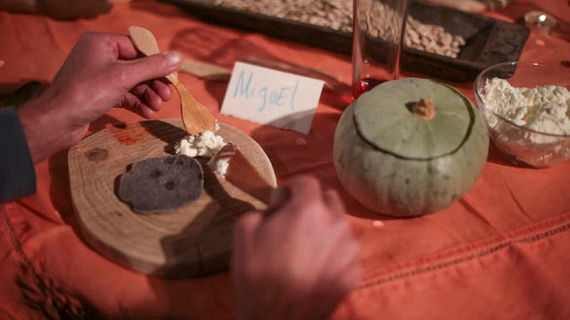
Hubbard Squash Project
2014
various locations, Northern New Mexico
site-based research | food production | education initiative | public events
The Hubbard Squash Project was a seed-sharing initiative that involved growing squash, exchanging seeds and stories with other farmers, hosting dinners, as well as a series of education programs and a small publication. Local farms have been growing and saving Hubbard Squash seeds for many years. In the development of this particular project, several seasons were spent cultivating this squash in Trampas, NM where a relationship was formed with the plant and as a food source native to New Mexico. Most of the growers that were involved in the seed exchange spent time on the farm and grew familiar with the squash; many went on to various places to start their own farms.
The project developed over a year as part of the Santa Fe Art Institute's Food Justice-themed residency program. Collaborating partners: Ann Schnake of MobileInTent, Ursula Marie Berzborn, Victor Figueroa Infante & Marlet Torres Martinez of la compania de artes vivas ALARETE, Lida Nosrati & Keith Guambana Smith.
THE SQUASH & ITS SEED
The Trampas Hubbard Squash is native to New Mexico and carries a story specific to place. Growing the squash became a way to form and share a new awareness of this traditional food source and became an impetus for extending communities.
As part of a seed exchange, four growers across the U.S. received a package containing Hubbard Squash seeds and a manual designed to tell the story of this landrace variety. The seed became a contract between the grower and the continuation of a living native seed culture, a food source and also a form of food justice. Each grower documented their crop, shared images, soil samples, and a fully grown squash.

DISTRIBUTION
A used farm pallet was made into a frame and filled with native Hubbard squash grown there during that season. The squash was distributed within the Santa Fe community - at farmers markets, natural food stores, to chefs, neighbors and artists in residence at SFAI. Over a two-week period the pallet frame was filled and emptied, marking time as well as the distribution and consumption of a native food source. Distribution was therefore a sculpture and a performance but also a way to distribute food.

THREE SISTERS DINNER
Three Sisters Dinner was a performative installation of seeds and squash, an exchange of native food grown at Jubilee Farm. As part of the Hubbard Squash Project, Food Justice residents at Santa Fe Art Institute were invited to the event. The dinner brought community together around the ritual of eating, sculpture, performance and big ideas.

EDUCATING CHILDREN
The project introduced the story of the seed to children to further knowledge and understanding about food security. Creative programming, designed as part of the Hubbard Squash Project brought diverse groups of children to the farm from the Santa Fe Waldorf School, and LaTierra Montessori Charter School at Moving Arts in Espanola, NM. The children participated in sensory-based activities, explored the squash and growing techniques, learned drawing and painting, and made seed libraries. Community-building extended to the families of the children who brought seeds home.

THE BOOK
Click here to download a PDF of the Hubbard Squash Project Book.












